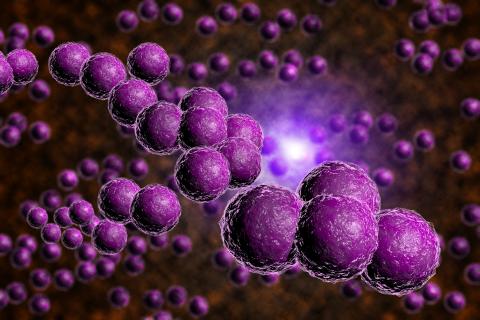Methicillin-Resistant Staphylococcus aureus (MRSA)
Staphylococcus aureus, or staph, is a bacterium found in the nose or on the skin of about 20–30% of people in the U.S. Staph bacteria are usually harmless, but they can sometimes cause serious infections. Most staph infections can be treated with antibiotics, but there are some strains that have developed antibiotic resistance.
Methicillin-resistant Staphylococcus aureus (MRSA) is the name for the strains of staph bacteria that have become resistant to certain antibiotics that are usually used to treat staph infections. It is the most common drug-resistant infection found in health care settings.
There are two main types of MRSA:
- Healthcare-associated MRSA (HA MRSA) is found mainly in hospital patients and long-term care facility residents.
- Community-associated MRSA (CA MRSA) is found in those who have not had contact with health care facilities.
HA MRSA
HA MRSA is acquired in health care facilities such as hospitals or nursing homes. It can be spread through contact with hands, clothes, or medical equipment that haven't been cleaned properly. MRSA can also spread by someone with an infected wound or by someone who carries the bacteria but shows no signs or symptoms of an infection (called colonization). People who receive inpatient medical care, have surgery, or require medical devices are at higher risk of MRSA infection.
Health care providers should take the following steps to reduce the risk of spreading MRSA infection:
- Clean hands with soap and water or alcohol-based hand sanitizer before and after caring for each patient.
- Properly clean rooms and medical equipment using products approved by the Environmental Protection Agency (EPA).
- Use contact precautions when caring for patients with MRSA.
CA MRSA
CA MRSA is spread in the community, most often in places that involve crowding, skin-to-skin contact, and shared equipment or supplies. It is spread by contact with people who are infected or colonized. It is also spread through objects that are contaminated with the bacteria such as towels, clothing, razors, and gym or sports equipment. Athletes, school students, and children who attend day care are at higher risk of CA MRSA infection.
Reduce your risk of CA MRSA infection:
- Wash your hands often, especially before and after changing bandages.
- Clean your body regularly, especially after exercise.
- Keep cuts, scrapes, and wounds clean and covered until healed.
- Do not share personal items such as towels and razors.
- See a doctor early if you think you might have a skin infection, especially if accompanied by a fever.
- Do not pick at or pop any skin sores.
The symptoms of MRSA infections depend on the part of the body that is infected. Most MRSA infections appear on the skin and can look like pimples or boils that are:
- Red
- Swollen
- Painful
- Warm to the touch
- Full of pus or other drainage
These signs may also be accompanied by a fever. Sometimes staph bacteria can cause more severe infections such as pneumonia, bloodstream infections, and sepsis.
Treatment of MRSA depends on the location and severity of the infection. Some infections are treated by draining the pimples or boils while others will require antibiotics. People who are colonized with MRSA often do not require treatment.
It is important to treat MRSA infections early. If left untreated, MRSA can spread throughout the body and cause more serious infections like sepsis.
Resources
- Methicillin-resistant Staphylococcus aureus (MRSA) Frequently Asked Questions (FAQ): FAQ for patients and family members of patients with MRSA.
- Methicillin-resistant Staphylococcus aureus (MRSA) Fact Sheet, P-42073 (Multiple Languages): A fact sheet on MRSA with general disease information and precautions to take to prevent MRSA.
- Community-associated Methicillin-resistant Staphylococcus aureus (CA MRSA) Fact Sheet, P-42185 (Multiple Languages): A fact sheet on CA MRSA with general disease information and prevention measures.
- Community-associated Methicillin-resistant Staphylococcus aureus (CA MRSA) Patient Pamphlet, P-42170 (Multiple Languages): CA MRSA patient information and prevention tips
- Community-associated Methicillin-resistant Staphylococcus aureus (CA MRSA) Guidelines for Controlling Transmission Among Students and Athletes, P-42179 (PDF): Recommendations such as hand and personal hygiene, screening athletes for skin infections, and protecting skin from injury to help reduce CA MRSA skin infections in school settings and among athletes.
- Community-associated Methicillin-resistant Staphylococcus aureus (CA MRSA) Prevention and Control in Athletes (PPT): A PowerPoint presentation to educate students, sports team members, coaches, school administrators, school nurses, and parents on guidelines for preventing CA MRSA infections in schools and among sports team members.
- Guide for Prevention and Control of Multidrug-Resistant Organisms in Health Care Settings, P-42513 (PDF): A guide to help health care organizations implement comprehensive plans to manage patients, residents, and clients with multidrug-resistant organisms.
- Community-associated Methicillin-resistant Staphylococcus aureus (MRSA) Guidelines for Clinical Management and Control of Transmission, P-42160 (PDF): Discusses the epidemiology of community-associated MRSA and offers treatment guidance and infection control and prevention measures for both health care and community settings.
- Community-associated Methicillin-resistant Staphylococcus aureus (CA MRSA) Patient Pamphlet, P-42170 (Multiple Languages): CA MRSA patient information and prevention tips. Health care providers and local public health agencies can use this pamphlet to provide patients with general CA MRSA information and prevention tips.
Questions about MRSA? Contact us.
Phone: 608-267-7711 | Fax: 608-266-0049

